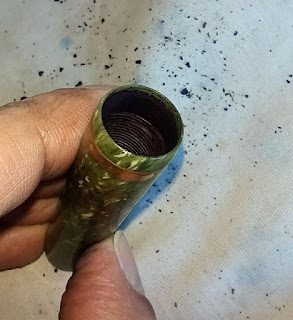My experiment for this week.
Recently I got hold of some stylographic pens called Imperial made by a Czech now-defunct company called J. Brod & Co. These were wartime production pens and none of the piston filler mechanisms work, but that is for later. The
seller kindly included a bunch of spare and broken parts as a free gift
so my brain went on overdrive wondering what to do with them since they
could not help me fix the piston filler units anyway.
After thinking a while, I looked through my 'experiment' pens and decided to try a conversion. There were a couple of sections among the spares with no broken bits so I took one apart and gave it a thorough cleaning. The most important part, the weighted wire, was thankfully OK. One of the pens, an eyedropper, had a barrel that fit the section readily. I think it is a Woodex, before it became Woodex. I applied some silicon grease to the threads and here we are! It remains to be seen how this setup will deal with burping, if it occurs.
I'm fascinated by the simplicity of the mechanism, considering that the main parts involved are the weighted wire that regulates the ink flow, and the section tip (which itself can be disassembled from the section) that's similar to a roller ball but without the ball. It's surprisingly smooth with absolutely no scratchiness on paper.
These are the basic parts. Of course the main piston unit is still attached.
Here you see the tip, the weighted wire that is inside, and the section itself.
The
tip itself is interesting. There is a channel along the threads that
looked like a crack to me initially. Then I realized that it must be an
air channel for the ink to be drawn in as the tiny mouth would be too
narrow for that purpose. When I was priming the eyedropper, the ink was
expelled from the very edge of the conical part.






























